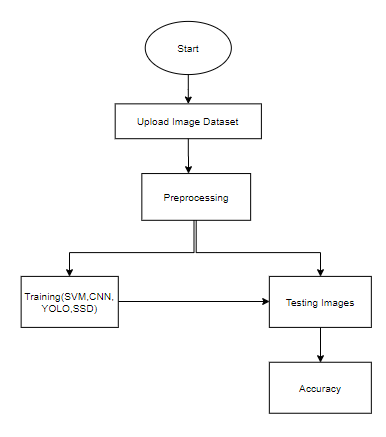Enhancing Accuracy in Detecting Vehicles Using Sift Over SVM, CNN, Yolo, SSD
Project Code :TCMAPY492
Objective
The main objective of this project to augment the accuracy and detecting the vehicles using scalar invariant feature transform (SIFT) in SVM, CNN, YOLO, SSD for image dataset.
Abstract
Unmanned aerial vehicles (UAVs) for civilian remote
sensing have sparked a lot of interest in recent years due to the numerous new
applications they may provide. One of them is the automatic detection and
counting of automobiles. We provide a revolutionary car detecting algorithm in
this research. It begins with a feature extraction method based on the scalar
invariant feature transform (SIFT), which identifies and describes a set of key
points in the considered image. Using a support vector machine (SVM) classifier,
CNN, YOLO, SSD, the procedure differentiates between key points associated with
autos and those associated with all other objects. The experiments were carried out on a real-life UAV
setting. They show how the proposed method can produce fascinating detection
results. Vehicle identification and categorization using vision has become a
hot topic in intelligent transportation systems research. However, due to the
constantly changing state of the roads, this duty is extremely difficult and
demanding. Researchers have proposed a number of strategies to address these
issues. Some of them provide good results but are computationally expensive and
fail in some situations. A feature-based cost-effective detection and
classification method is proposed in the suggested method, which is ideal for
real-time applications, has adequate accuracy, and is computationally
inexpensive. The suggested method uses Haar-like features are digital image
features used in object recognition of the pictures and SVM classifier for
detection which delivers a very rapid detection rate with good accuracy. We
propose using two virtual detection lines (VDL) to lower the false positive
rate caused by this method, which reduces the false positive rate. A
feature-based technique is proposed for predicting a vehicle's class. SIFT is a
well-known picture classification feature. Existing feature-based vehicle
categorization systems are inaccurate due to inefficient usage of such
features. In order to lessen the number of people who are missing. Identifying
the vehicle's class by multi class SVM classifier, CNN, YOLO, SSD. Achieve
multi class prediction with SVM. Extensive experiments have been carried out on
different traffic data of varying environments to evaluate the detection and
classification performance of the proposed method. Experiment results
demonstrate that the proposed method achieves a significant improvement in
classification of heterogeneous vehicles in terms of accuracy with a
considerable execution time as compared to other methods.
Keywords - SVM classifier, CNN, YOLO, SSD, Scalar Invariant Feature Transform (SIFT), Traffic Data Images, Vehicles.
NOTE: Without the concern of our team, please don't submit to the college. This Abstract varies based on student requirements.
Block Diagram

Specifications
H/W Specifications:
- Processor : I5/Intel Processor
- RAM : 8GB (min)
- Hard Disk : 128 GB
S/W Specifications:
- Operating System : Windows 10
- Server-side Script : Python 3.6
- IDE : Jupyter notebook
- Libraries Used : Numpy, IO, OS, Keras, pandas, tensorflow, OpenCV
Learning Outcomes
LEARNING OUTCOMES:
- Practical exposure to
- Hardware and software tools
- Solution providing for real time problems
- Working with team/individual
- Work on creative ideas
- Testing techniques
- Error correction mechanisms
- What type of technology versions is used?
- Working of Tensor Flow
- Implementation of Deep Learning techniques
- Working of CNN algorithm
- Working of Transfer Learning methods
- Building of model creations
- Scope of project
- Applications of the project
- About Python language
- About Deep Learning Frameworks
- Use of Data Science
Related Projects
Related Topics





 Paper Publishing
Paper Publishing
